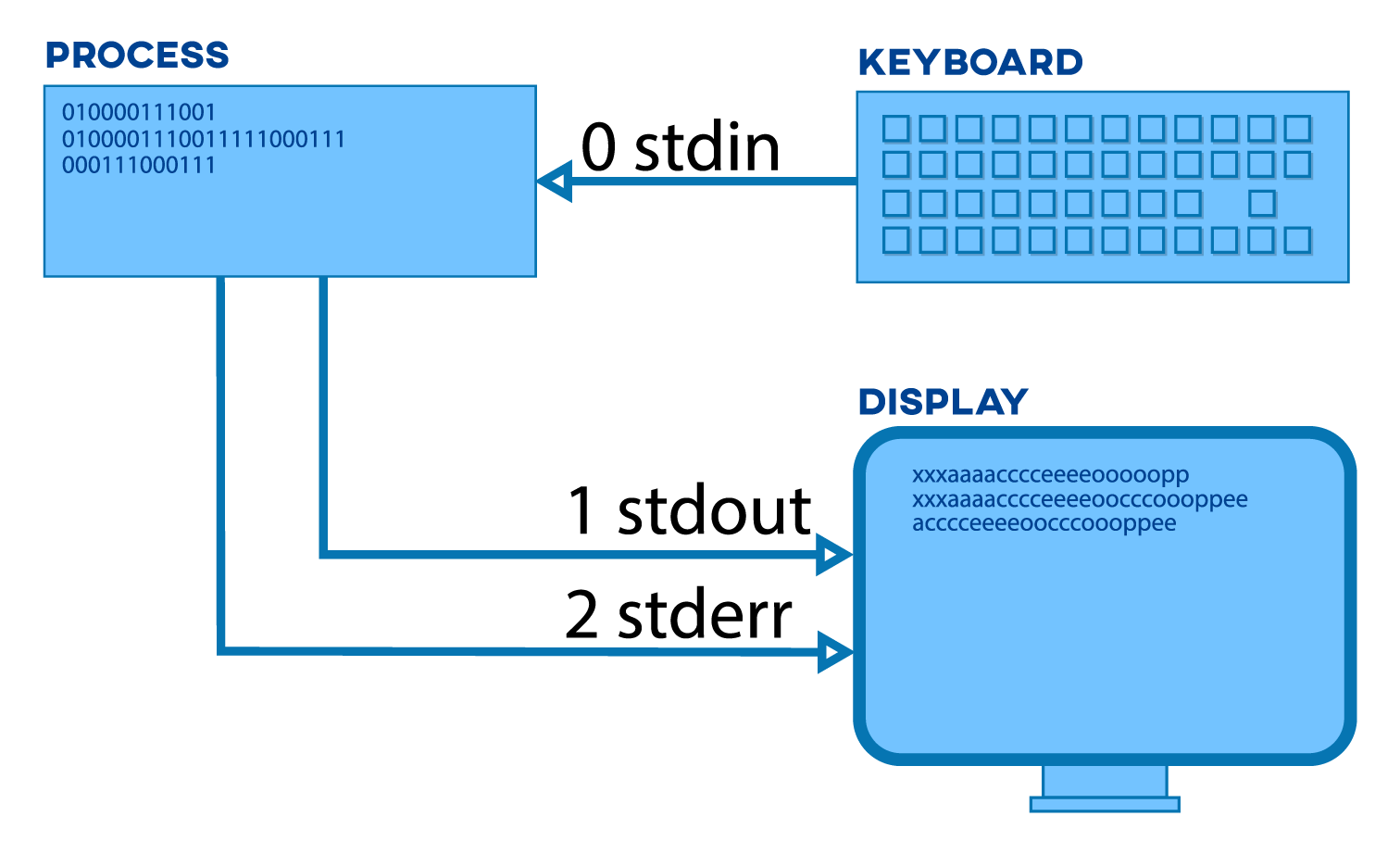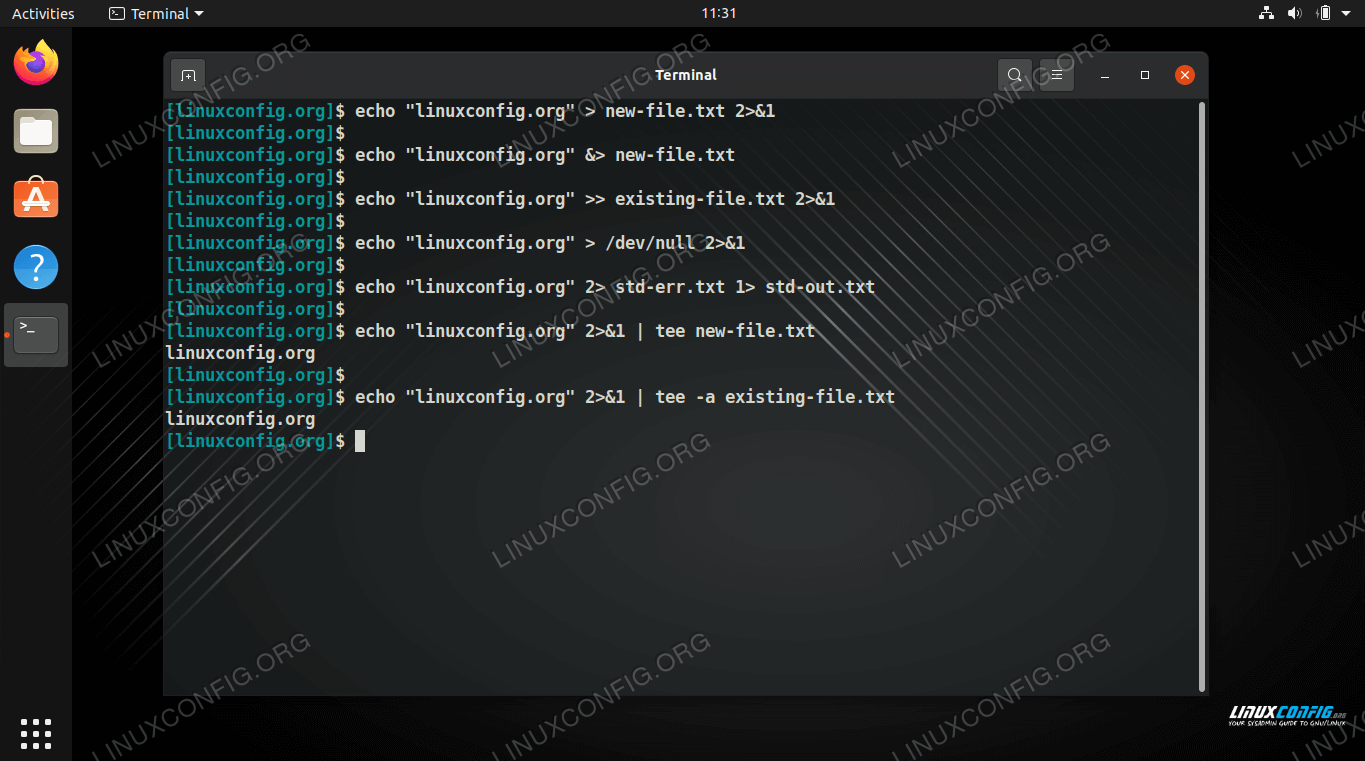Table of Contents
If you notice standard error and bash redirection output, the following user guide will help you.
PC running slow?
If you pass the command capability to a file, you will find that most error messages are printed to the terminal window. Every command that runs in almost every Linux shell, such as bash, uses three efficient regular I/O streams. To represent each stream, useThe file number descriptor is given.
In this article, we will collect reports related to stdout redirection and stderr-to-file.
Standard Output (stdout):
How do you redirect standard error to standard output?
redirect stdout to a file also redirect stderr to another file: error sold for> out 2>.Redirect stdout to document (> out), then redirect stderr to stdout (2> & 1): handle> out 2> & 1.
Every operation-based procedure in Linux uses virtually every default location to execute a command. Everyone calls this term “stdout”, “standard output” to make it simpler and easier. Your bash or zsh shell is constantly looking for the default output location. When the shell sees new output, it projects it onto the terminal screen so you can see it. Otherwise, it is recommended to view the default location.
Standard Error (stderr):
Standard error or stderr is similar to standard input and standard output, but is only used to store error messages. A general error can be redirected to this command line or file using the machine. If you want to log or occasionally log messages to a separate log file but want to hideRedirecting stderr will probably help to get error messages. Now let’s get to the practical side of redirecting stdout and stderr.
Redirect Stdout And Stderr To The Same File:

Redirection is a method of capturing model output and sending it from one source to another command or file. I/O streams can be redirected using the n> operator, where n is basically the file descriptor number. For looping stdout we use “1>” and for stderr “2>” is often an added operator.
We have this file named “sample.txt” for redirected output of the seller in our current directory.
How do you redirect standard error and standard output to a file?
To redirect stderr (standard error) to a file: Control 2 > errors.txt.Let’s redirect both stderr and stdout (standard output): command &> output.txt.Finally, we must redirect stdout to a file called myoutput.txt and then redirect stderr to stdout with 2>&1 (errors.txt):
The file (command >) is considered the original redirect operator, simply redirecting the generic output with standard error displayed inside the terminal. We will also show different ways to redirect stderr.
Redirect Stderr To This Standard Output In Separate Files:
Below is the complete command syntax for redirecting stdout and stderr to truly separate files.

The following command also redirects output of messages about errors from file “out” to file “error”.
Stderr Redirect To Stdout:
Usually, stderr is combined with the stdout of the new program to keep everything in one file. Here is the processing syntax for redirecting stderr to stdout:
>In addition to redirecting, redirect the stdout file to the example .txt file and 2>&1 redirect the stdout file to the location of the stdout file stream.
If stderr is redirected first, stdout uses the following command to redirect all stdout output to a file.
Redirect
Stdout Stderr In One File:
Not all shells support this form redirection, but bash and zsh do. Stdout and stderr can be redirected using the following syntax.
In the next section linked to the article, we’ll look at these examples separately for redirecting stdout and stderr.
Redirect Standard Output To File:
Standard output is usually denoted by a “1” in the file descriptor number entry. To affect a transfer without any file descriptor number, the array ends its value with “1”. The format for redirecting stdout to the beginning is:
We usually use the “sample.file” file to save the standard output with the “ls -al” command
Stderr File Redirect:
How do I redirect a bash error?
To re-center stderr (standard error) on a good solid file: Command 2> Error.txt.Let’s redirect both stderr and stdout (standard output): put it in &> output.txt.Finally, we can pipe stdout to a file named myoutput.txt and then redirect stderr to stdout with 2> & 1 (errors.txt):
Use the “2>” operator to find the standard output of a file.
Maybe we can combine for and stderr stdout with a single redirect command.
In the specific example below, error messages are present in the saved “error.txt” file, where “output.txt” is the standard output of the “ls” command.
Output:
The redirect process and file handles for I/O streams are very useful when working in the Linux terminal. In this article, our contributors covered common I/O waters, including stdout and stderr. The first web pages of this article contain detailed information about redirection, I/O streams, and the general digital descriptor file. Next, you saw a working example of different styles of passing stdout and stderr.
Talya Saif Malik
How do I redirect output and error to a file in Linux?
Command name> command name output.txt> stdout.txt.Command name 2> error.txt command name 2> stderr.txt.command1> out.txt 2> err.txt command2 -f -z -f ree p> out.txt 2> err.txt.Command1> all.txt 2> & 1 Command1 -arg> all.txt 2> & 1.
Talha is considered one of the authors of Linux Hint who is committed to helping the world. He loves to read and write directly, as well as talk about Linux, data, computers and technology.
3.6 Redirects
Before executing a command, it enters and exitscan sometimes be redirectedUse of a special notation that is normally interpreted by the shell.Redirection allows you to use file descriptors from commandsduplicated, configured, closed,refers to different files,and may well change the files the command reads and writes from.It is also possible to do a redirect to change the file to handlescurrent investment execution environment. Next redirectOperators can appear before or anywherejust buy or track the order.Redirects are collected in the order they appearleft that becomes right. sabotage
each may be preceded by a file descriptor numbermay instead be replaced by the word from the set varname.In this case, any redirected user other than>&- and <&-, the shell assigns a new larger file descriptorgreater than 10 and assign this situation to variable_name. If >&- , <&- is placed beforefrom varname, meaningThing that defines a file with varnameClose description.If variablename is normally specified, the redirect is preserved afteran area under commands that allows the shell programmer to manipulate filesmanually the lifetime of the descriptor.
PC running slow?
ASR Pro is the ultimate solution for your PC repair needs! Not only does it swiftly and safely diagnose and repair various Windows issues, but it also increases system performance, optimizes memory, improves security and fine tunes your PC for maximum reliability. So why wait? Get started today!

In descriptions immediately after, if the file descriptor is set to Volumeomitted, and the first redirect character”<“, operator, redirect refers to standard input (fileDescription 0). This is usually the first character of the redirect statement.equals ‘>‘, all redirects are performance default 1) (fileDescription.
How do I redirect standard output?
Normal output is now sent to standard output (STDOUT) and therefore error messages related to standard error (STDERR) are sent. If you immediately run the console output with a> sign, you will only redirect STDOUT. To redirect STDERR, you must specify 2> for the redirect character.
The word after the migration wizard belowDescriptions are subject to curly stretching, unless otherwise noted,Tilde expansion, parameter expansion, command substitution, arithmeticExpansion, quote removal, filename expansion, and word splitting.If it spans more than one word, Bash throws an accounting error.
Improve the speed of your computer today by downloading this software - it will fix your PC problems.How do I redirect both standard and standard error?
Redirect stdout to a file and additionally stderr to another file: command > on 2>error.Direct stdout to a file ( >out ), then direct stderr to stdout ( 2>&1 ): command >out 2>&1.
How do I redirect standard output and error to a file in Linux?
command name > output.txt command name > stdout.txt.command name 2 > error.txt command name 2 > stderr.txt.command1 > out.txt 2> err.txt command2 -f -z -y > out.txt 2> err.txt.command1 > all.txt 2>&1 command1 -arg > all.txt 2>&1.
Which of the following will redirect standard output to standard error?
log tells an intermediate shell thread to send standard output to a data file. log , and 2>&1 tells it that the market’s standard error (file descriptor 2) was successfully redirected to standard output (file descriptor 1).
Tips Voor Het Oplossen Van Standaardfouten En Het Omleiden Van De Beat-output
Conseils Pour Corriger Les Erreurs Quotidiennes Et Rediriger La Sortie Bash
Suggerimenti Per L’installazione Dell’errore Standard E Il Reindirizzamento Dell’output Bash
Советы по исправлению стандартной ошибки и перенаправлению вывода Bash
Sugerencias Con Respecto A Corregir El Error Estándar Y Redirigir La Salida Shindig
Tips För Att Rätta Till Standardfel Och Omdirigera Bash-utdata
Dicas Para Será Ensinado Erro Padrão E Redirecionando A Saída Do Bash
Wskazówki Dotyczące Wielu Napraw Błędów Standardowych I Przekierowywania Wyjścia Bash
Tipps Zum Erstellen Von Standardfehlern Und Umleiten Der Bash-Ausgabe
표준 오류 복원 및 Bash 출력 리디렉션을 위한 팁